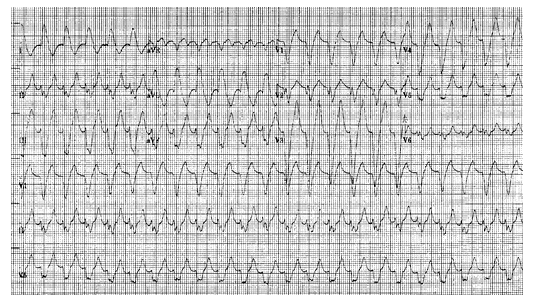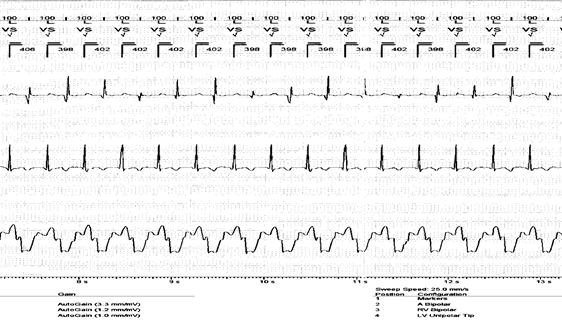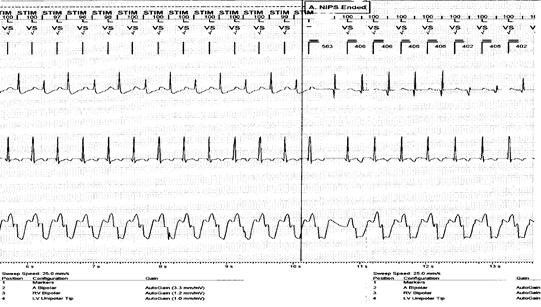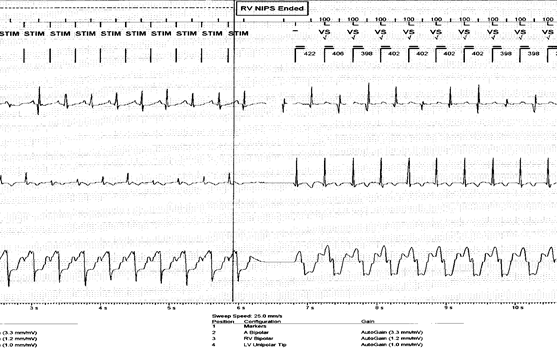A Case of Wide-Complex Tachycardia Due to Atrial Tachycardia Diagnosed by Non-Invasive Programmed Stimulation
Article Information
Daniel Sohinki MD, MSc1, Phi Wiegn MD2,3, Owen A. Obel MD2,3
1Medical College of Georgia at Augusta University, Augusta GA, USA
2 University of Texas Southwestern Medical Center, Dallas, TX, USA
3Veterans Health Administration (VA) North Texas Healthcare System, Dallas, TX, USA
*Corresponding Author: Dr. Daniel Sohinki, MD, MSc, FACC, FHRS, Medical College of Georgia at Augusta University, Department of Cardiology, 1150 15th Street, BBR 6518, Augusta, GA 30912, USA
Received: 164 December 2020; Accepted: 08 January 2021; Published: 15 January 2021
Citation: Daniel Sohinki, Phi Wiegn, Owen A. Obel. A Case of Wide-Complex Tachycardia Due to Atrial Tachycardia Diagnosed by Non-Invasive Programmed Stimulation. Archives of Clinical and Medical Case Reports 5 (2021): 143-147.
View / Download Pdf Share at FacebookAbstract
Keywords
Tachycardia; Non-ischemic cardiomyopathy; Wide-complex tachycardia
Tachycardia articles; Non-ischemic cardiomyopathy articles; Wide-complex tachycardia articles
Tachycardia articles Tachycardia Research articles Tachycardia review articles Tachycardia PubMed articles Tachycardia PubMed Central articles Tachycardia 2023 articles Tachycardia 2024 articles Tachycardia Scopus articles Tachycardia impact factor journals Tachycardia Scopus journals Tachycardia PubMed journals Tachycardia medical journals Tachycardia free journals Tachycardia best journals Tachycardia top journals Tachycardia free medical journals Tachycardia famous journals Tachycardia Google Scholar indexed journals Non-ischemic cardiomyopathy articles Non-ischemic cardiomyopathy Research articles Non-ischemic cardiomyopathy review articles Non-ischemic cardiomyopathy PubMed articles Non-ischemic cardiomyopathy PubMed Central articles Non-ischemic cardiomyopathy 2023 articles Non-ischemic cardiomyopathy 2024 articles Non-ischemic cardiomyopathy Scopus articles Non-ischemic cardiomyopathy impact factor journals Non-ischemic cardiomyopathy Scopus journals Non-ischemic cardiomyopathy PubMed journals Non-ischemic cardiomyopathy medical journals Non-ischemic cardiomyopathy free journals Non-ischemic cardiomyopathy best journals Non-ischemic cardiomyopathy top journals Non-ischemic cardiomyopathy free medical journals Non-ischemic cardiomyopathy famous journals Non-ischemic cardiomyopathy Google Scholar indexed journals cardiomyopathy articles cardiomyopathy Research articles cardiomyopathy review articles cardiomyopathy PubMed articles cardiomyopathy PubMed Central articles cardiomyopathy 2023 articles cardiomyopathy 2024 articles cardiomyopathy Scopus articles cardiomyopathy impact factor journals cardiomyopathy Scopus journals cardiomyopathy PubMed journals cardiomyopathy medical journals cardiomyopathy free journals cardiomyopathy best journals cardiomyopathy top journals cardiomyopathy free medical journals cardiomyopathy famous journals cardiomyopathy Google Scholar indexed journals Wide-complex tachycardia articles Wide-complex tachycardia Research articles Wide-complex tachycardia review articles Wide-complex tachycardia PubMed articles Wide-complex tachycardia PubMed Central articles Wide-complex tachycardia 2023 articles Wide-complex tachycardia 2024 articles Wide-complex tachycardia Scopus articles Wide-complex tachycardia impact factor journals Wide-complex tachycardia Scopus journals Wide-complex tachycardia PubMed journals Wide-complex tachycardia medical journals Wide-complex tachycardia free journals Wide-complex tachycardia best journals Wide-complex tachycardia top journals Wide-complex tachycardia free medical journals Wide-complex tachycardia famous journals Wide-complex tachycardia Google Scholar indexed journals biventricular articles biventricular Research articles biventricular review articles biventricular PubMed articles biventricular PubMed Central articles biventricular 2023 articles biventricular 2024 articles biventricular Scopus articles biventricular impact factor journals biventricular Scopus journals biventricular PubMed journals biventricular medical journals biventricular free journals biventricular best journals biventricular top journals biventricular free medical journals biventricular famous journals biventricular Google Scholar indexed journals treatment articles treatment Research articles treatment review articles treatment PubMed articles treatment PubMed Central articles treatment 2023 articles treatment 2024 articles treatment Scopus articles treatment impact factor journals treatment Scopus journals treatment PubMed journals treatment medical journals treatment free journals treatment best journals treatment top journals treatment free medical journals treatment famous journals treatment Google Scholar indexed journals PEComas articles PEComas Research articles PEComas review articles PEComas PubMed articles PEComas PubMed Central articles PEComas 2023 articles PEComas 2024 articles PEComas Scopus articles PEComas impact factor journals PEComas Scopus journals PEComas PubMed journals PEComas medical journals PEComas free journals PEComas best journals PEComas top journals PEComas free medical journals PEComas famous journals PEComas Google Scholar indexed journals surgery articles surgery Research articles surgery review articles surgery PubMed articles surgery PubMed Central articles surgery 2023 articles surgery 2024 articles surgery Scopus articles surgery impact factor journals surgery Scopus journals surgery PubMed journals surgery medical journals surgery free journals surgery best journals surgery top journals surgery free medical journals surgery famous journals surgery Google Scholar indexed journals microphthalmia articles microphthalmia Research articles microphthalmia review articles microphthalmia PubMed articles microphthalmia PubMed Central articles microphthalmia 2023 articles microphthalmia 2024 articles microphthalmia Scopus articles microphthalmia impact factor journals microphthalmia Scopus journals microphthalmia PubMed journals microphthalmia medical journals microphthalmia free journals microphthalmia best journals microphthalmia top journals microphthalmia free medical journals microphthalmia famous journals microphthalmia Google Scholar indexed journals tomography articles tomography Research articles tomography review articles tomography PubMed articles tomography PubMed Central articles tomography 2023 articles tomography 2024 articles tomography Scopus articles tomography impact factor journals tomography Scopus journals tomography PubMed journals tomography medical journals tomography free journals tomography best journals tomography top journals tomography free medical journals tomography famous journals tomography Google Scholar indexed journals
Article Details
1. Case Presentation
A 59 year old man with a history of non-ischemic cardiomyopathy (NICM), severely depressed left ventricular systolic function (LVSF) and New York Heart Association (NYHA) class III heart failure symptoms presented with palpitations and chest discomfort. He had a biventricular (BiV) ICD implanted 3 years previously (St. Jude Medical, Unify© CRT-D). Pacing had been set to DDD mode with a maximum tracking rate of 125 beats-per-minute (bpm). The initial 12-lead electrocardiogram showed a regular, wide-complex tachycardia (WCT) with a left bundle branch block (LBBB) type pattern at a rate of 139 beats-per-minute (Figure 1). Interrogation of the device revealed ongoing tachycardia with a cycle length of 400 msec (Figure 2). Pacing maneuvers to diagnose the tachycardia mechanism were performed through the BiV ICD (Figures 3 and 4). What was the tachycardia mechanism?.

Figure 1: Initial 12-lead electrocardiogram showing the patient’s wide-complex tachycardia. Features that were initially suggestive of ventricular tachycardia (VT) included notched down-stroke of the S wave in lead V2, pre-cordial concordance, and an RS interval >100 ms in lead V6.

Figure 2: Initial device interrogation showing the tachycardia. Note the 1:1 A:V relationship.

Figure 3: Entrainment via non-invasive programmed stimulation (NIPS) from the atrium. Note the Ap-Vs-As response, excluding the diagnosis of ventricular tachycardia (VT).

Figure 4: Entertainment via non-invasive programmed stimulation (NIPS) from the ventricle. Note the Vp-As-As-Vs response, confirming the diagnosis of atrial tachycardia (AT).
2. Discussion
The differential diagnosis for the WCT included ventricular tachycardia (VT), supraventricular tachycardia (SVT) with aberrancy, pre-excited tachycardia, and pacemaker-mediated tachycardia (which was quickly excluded by the fact that rate of the WCT rate was faster than the programmed upper tracking rate). Several electrocardiographic features were suggestive of VT including a notched down-stroke of the S wave in lead V2 [1], pre-cordial concordance [2], and RS interval >100 msec in lead V6 [3] (Figure 1). The initial device interrogation revealed a tachycardia with a 1:1 A:V relationship (Figure 2). Since the diagnosis was initially considered most likely to be VT, atrial entrainment to confirm the diagnosis was first performed via non-invasive programmed stimulation (NIPS) which elicited a Ap-Vs-As, thus excluding the diagnosis of VT for which an Ap-Vs-Vs-As response would be expected [4] (Figure 3). Because of this, a diagnosis of SVT was made leaving 3 remaining possibilities, all of which would result in an Ap-Vs-As response to atrial entrainment: AV nodal reentrant tachycardia (AVNRT), and atrial tachycardia (AT), (either with aberrancy, or utilizing an accessory pathway as a bystander), or atrioventricular reentrant tachycardia (AVRT) – (either orthodromic with aberrancy or antidromic). Thus, ventricular entrainment via the BiV ICD system to establish the diagnosis was performed, again utilizing NIPS which elicited a Vp-As-As-Vs response (Figure 4). This was diagnostic of atrial tachycardia, excluding both AVNRT and AVRT, for which a Vp-As-Vs response would be expected [5]. Further differentiation of these 2 diagnoses may have been possible using criteria such as the post-pacing interval-minus tachycardia cycle length [6].
After the mechanism of the tachycardia was defined by device programmed stimulation, the patient was admitted to the telemetry unit for monitoring and optimization of medical therapy, including up-titration of Metoprolol to a slow-release dose of 200mg daily. After having repeated episodes of the tachycardia, he underwent an electrophysiology study one month later. A right atrial tachycardia was induced and ablated successfully. The patient has not had recurrence of sustained atrial tachycardia at 1 year follow up.
This case illustrates the utility of an indwelling cardiac pacing device to rapidly and noninvasively establish the diagnosis of tachycardia and guide an appropriate therapeutic strategy. The initial presumptive diagnosis was VT based on patient’s history and 12-lead ECG. Had atrial entrainment not been performed rapidly excluding VT, the short- and long-term therapeutic strategies might have been completely different. For example, an incorrect diagnosis of VT might have resulted in early cardioversion in the short-term, and anti-arrhythmic drug might have been chosen before ablation, or might have been empirically chosen. Once the diagnosis of an atrial tachycardia had been established, prompt and appropriate therapy of metoprolol was initiated. Had the diagnosis been AVRT or AVNRT, ablation would have been likely chosen as first-line. Lastly, the diagnosis of atrial tachycardia was useful in planning for the follow-up ablative procedure that was proven to be effective in this patient.
References
- Kindwall KE, Brown J, Josephson ME. Electrocardiographic criteria for ventricular tachycardia in wide complex left bundle branch block morphology tachycardias. Am J Cardiol 61 (1988): 1279-1283.
- Wellens HJJ, Bar FWHM, Lie KI. The value of the electrocardiogram in the differential diagnosis of a tachycardia with a widened QRS complex. Am J Med 64 (1978): 27-33.
- Brugada P, Brugada J, Mont L, et al. A new approach to the differential diagnosis of a regular tachycardia with a wide QRS complex. Circ 83 (1991): 1649-1659.
- Abdelwahab A, Gardner MJ, Basta MN, et al. A technique for the rapid diagnosis of wide complex tachycardia with 1:1 AV relationship in the electrophysiology laboratory. PACE 32 (2009): 475-483.
- Knight BP, Ebinger M, Oral H, et al. Diagnostic value of tachycardia features and pacing maneuvers during paroxysmal supraventricular tachycardia. J Am Coll Cardiol 36 (2000): 574-582.
- Michaud GF, Tada H, Chough S, et al. Differentiation of atypical atrioventricular node re-entrant tachycardia from orthodromic reciprocating tachycardia using a septal accessory pathway by the response to ventricular pacing. J Am Coll Cardiol 38 (2001): 1163-1167.
